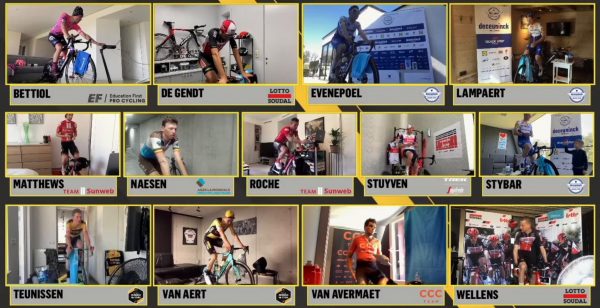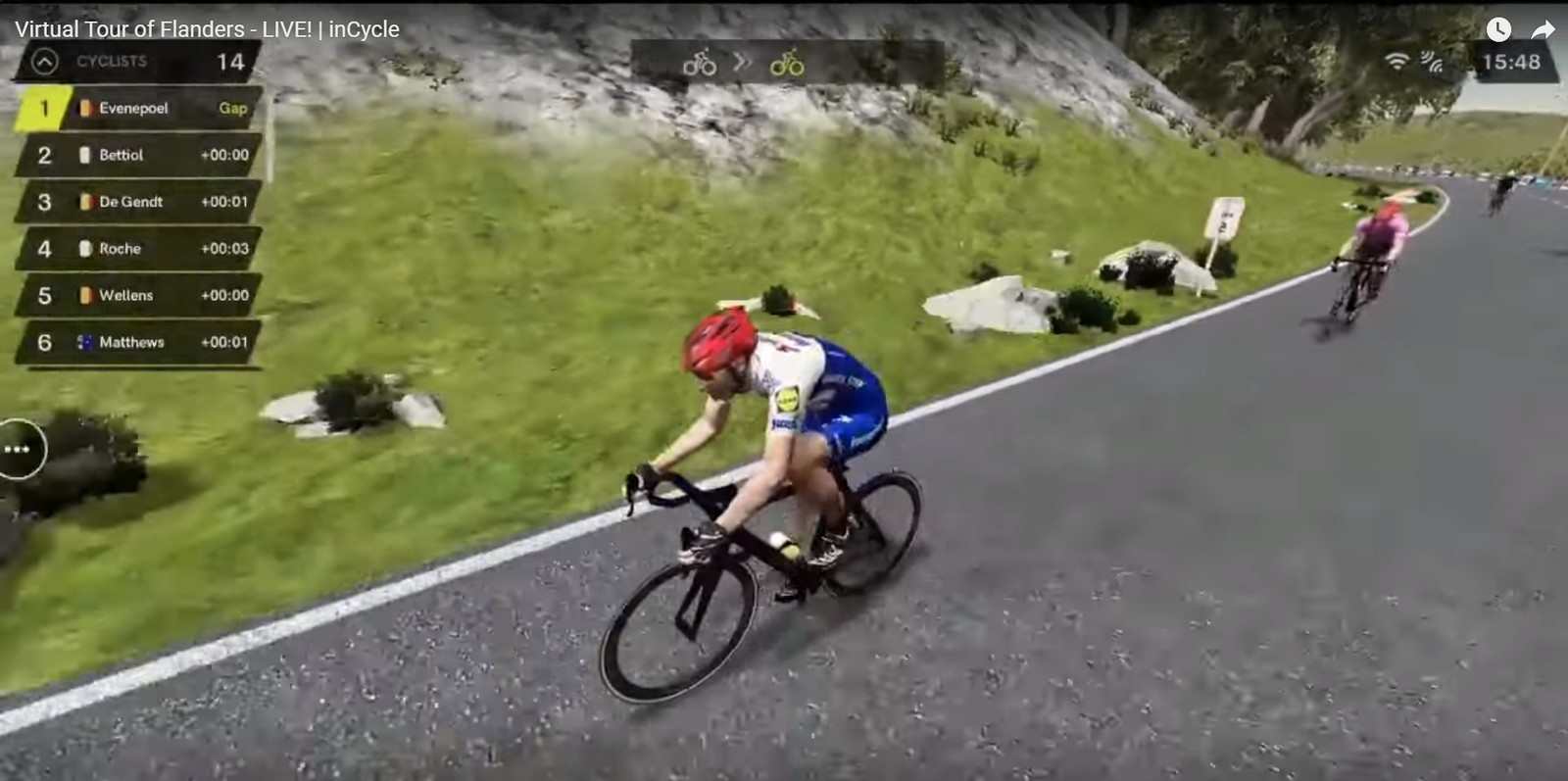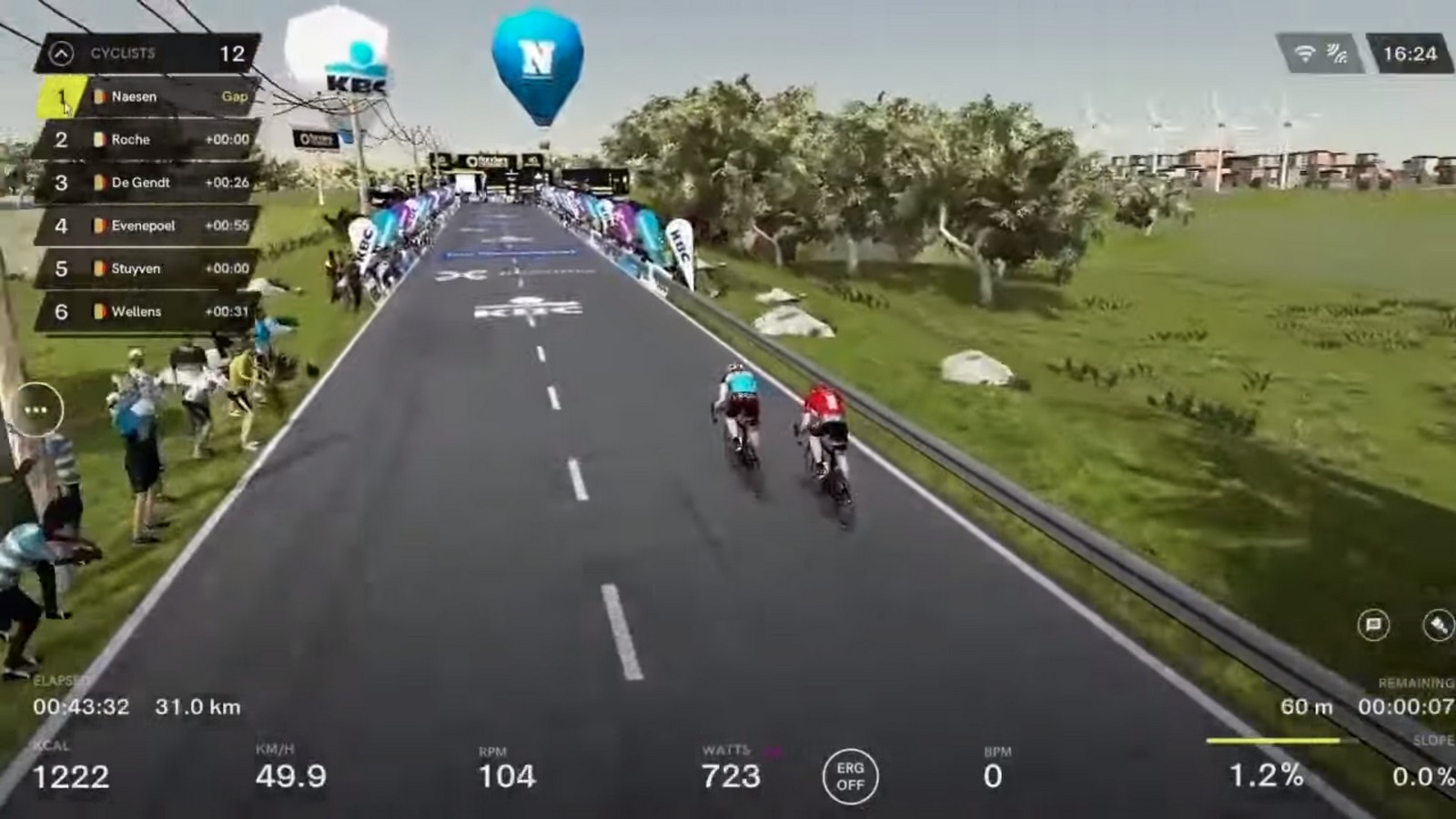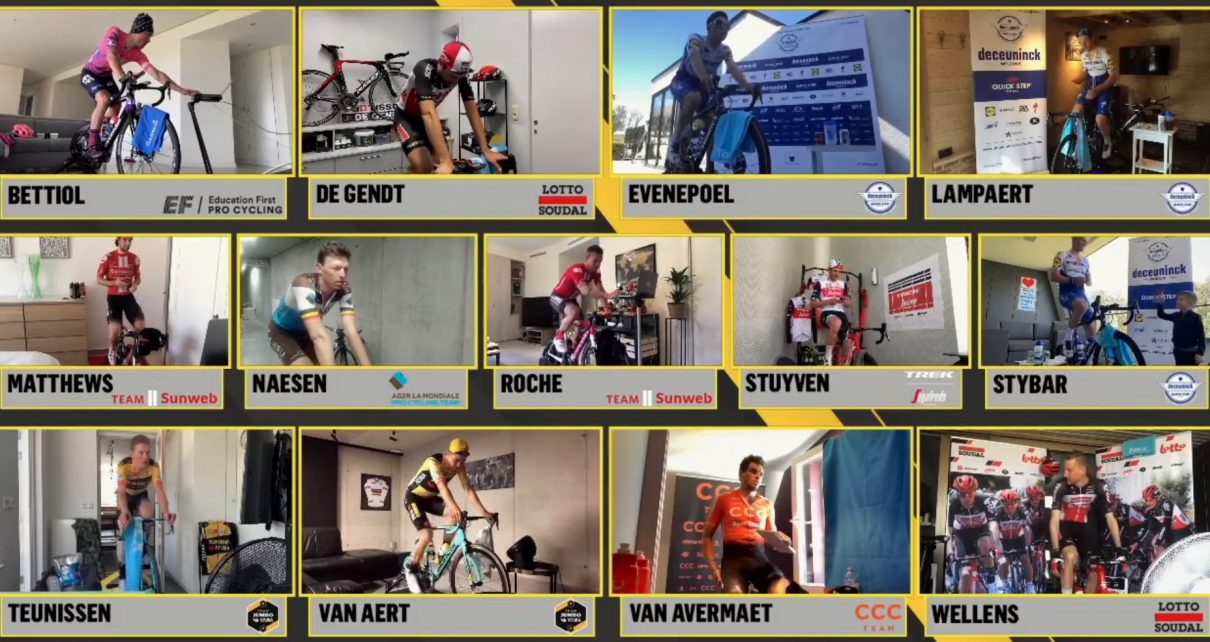With road racing on hold amidst the global COVID-19 pandemic, thousands of riders from around the world have been moving their training indoors. The rise of Zwift, BKool, FulGaz, and many other virtual riding platforms, means there is no limit to how far you can pedal through virtual worlds both real and imagined.
Both professionals and amateurs have been itching to race as well, and on Sunday, April 5, 13 of the world’s best cyclists gathered on the start line of the Virtual Tour of Flanders on the Bkool platform. While the COVID-19 pandemic forced the real-life race into postponement, the virtual title was still up for grabs.
Twenty-year-old phenom Remco Evenepoel (Deceuninck-Quick-Step) was an early aggressor in the 30.9 km race, but he fell back when Greg Van Avermaet (CCC) put in a blistering attack on the ultra-steep Paterberg with less than 10 km to go. GVA soloed to victory, finishing in a time of 43 minutes and 17 seconds, while Oliver Naesen (AG2R La-Mondiale) beat Nicolas Roche (Sunweb) in the sprint for second, the pair finishing 20 seconds behind Van Avermaet.
By the looks of the riders’ faces – etched with pain and glimmering sweat – the Virtual Tour of Flanders was one of the hardest races they’d ever done.
In the post below we take a closer look at the power files of first- and third-place finishers: Van Avermaet and Roche. For context on the numbers you’ll see below, be sure to check out this post that provides insight about the power outputs of professional male cyclists.
Nicolas Roche
Height: 1.78 m (5 ft 10 in)
Weight: 154 lbs (70 kg)
Time: 43:38
Average power: 399 W (5.7 W/kg)
Max power: 792 W
Greg Van Avermaet
Height: 1.81 m (5 ft 11 in)
Weight: 163 lbs (74 kg)
Time: 43:17
Average power: 434 W (5.86 W/kg)

Analysing the race
The 2020 Virtual Tour of Flanders took place on a 30.9 km course which featured three of the most famous Belgian bergs: the Kruisberg, Oude Kwaremont, and the Paterberg. After a relatively compact start, riders hit the Kruisberg with its average gradient of 5% and maximum of 9%. Evenepoel went to the front, while Van Avermaet and Roche stayed in the group behind. As expected on such a short course, the group went full-gas up each and every climb, as evident in the massive numbers put out by Roche.
Kruisberg:
Time: 1:34
Average power: 531 W (7.6 W/kg)
Midway through the race, riders hit the infamous Oude Kwaremont, a 2.2 km climb with a maximum gradient of 11.6%. While the real-life cobbles of the Kwaremont can be hard to handle, the virtual version doesn’t quite live up to the reputation — it’s merely a big bump in the road that forced the riders to eke out a few more watts. As the front group hit the climb, Roche led from the front, holding nearly 500 W for the majority and coming out on the right side of the split as riders crested the top.
Oude Kwaremont:
Time: 3:56
Power: 462 W (6.6 W/kg)
The front group was now down to five as it hit the bottom of the Paterberg a few kilometres later. A short, sharp, and nasty 360-metre climb, the Paterberg holds an average of 12.9% with a maximum over 20%. Van Avermaet shot out from the bottom and immediately blew the group to bits. Virtual race cameras stayed with Evenepoel who was getting dropped like a rock while still doing 480 W. Roche was able to stay near the front, but no one could match Van Avermaet’s acceleration.
Paterberg:
Time: 1:30
Power: 531 W (7.6 W/kg)

Evenepoel led solo early on but was later dropped.
With GVA up the road with a 20-second lead, and the chase group down to three, Naesen put in a big attack just inside 3 km to go. Roche reacted immediately, while Thomas De Gendt began to fall back.
Following Naesen’s Attack:
Time: 0:52
Power: 535 W (7.6 W/kg)
Roche and Naesen worked together over the final couple of kilometres, but they could barely put a dent into Van Avermaet’s lead. GVA dug deep all the way to the line as the sprint began to open up behind. Roche took the early lead, but Naesen was able to come around the Irishman in the final 50 metres to take second place.
Final sprint:
Time: 0:22
Power: 655 W (9.4 W/kg)
If these sprint numbers seem low, keep in mind that Roche had been doing around 400 W for the last 43 minutes.

Naesen leading Roche into the finish for second.
The 2020 Virtual Tour of Flanders will go down in history for more reasons than one. It gave us a unique look into the world of professional virtual cycling, where teammates and tactics don’t matter as much, and technical skill is completely muted. We also got a glimpse of how deep a professional can go during a 43-minute race. Life-long cycling fans are used to four-, five-, six-, or even seven-hour races. But the Virtual Tour of Flanders was more like a high-powered slugfest than a carefully calculated marathon.
In the end, it was Greg Van Avermaet who took the victory, becoming the first (and perhaps only) winner of the Virtual Tour of Flanders.
About the author
Zach Nehr is a Level 3 USA Cycling coach, a Cat 1 cyclist and a graduate from Marian University where he received a Bachelor’s Degree in Exercise Science and Psychology. He is currently undertaking a Masters degree in Physiology.
This is not a paywall…
Our mission is to bring you the best content in the world that showcases the beauty of cycling in all its glory. We want to inspire people to love the sport as much as we do, and ultimately pull you away from the computer to get out for a ride.
So we can keep doing this to the best of our ability, please join our mission by becoming a member.
From exclusive content to premium benefits, join us and experience all we have to offer. Or feel free to continue reading the article.



